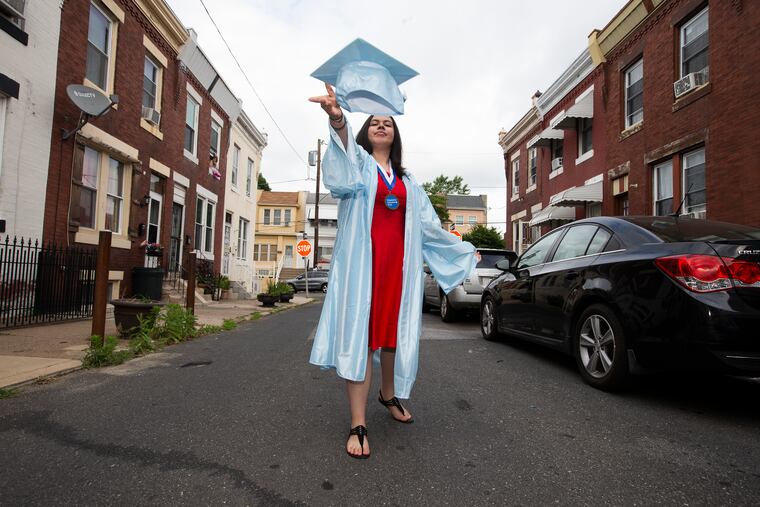Philadelphians are more college-educated than ever, but other challenges persist, ‘State of the City’ report shows
For the first time ever, the share of college-educated residents hit 35%

As Philadelphia emerges from the pandemic, gains in employment, a record share of college-educated residents, and slightly higher household incomes show a city in the midst of recovery, despite continuing problems with crime.
Those insights and more are part of the “State of the City” report released Wednesday by the Pew Charitable Trusts. Each year, the sweeping analysis takes a temperature read of Philadelphia’s economy, the health of its residents, crime and housing statistics, among other metrics, while stacking those figures against those of other large metropolitan areas.
Though the nation has avoided a full-blown recession, high rates of inflation have led to a precarious situation for many Philadelphians, who are spending larger chunks of their income on rent and face dizzying home prices. Poverty levels have begun to drop, though deep poverty — more than 10% of the city’s families make $12,875 or less per year — hasn’t budged.
Meanwhile, a staggering number of Philadelphians report being affected by gun violence, as shootings and homicides remain near highs seen in 2021. With crime a top issue in the upcoming mayoral primary election, it’s no secret that many residents are pessimistic about the direction they see the city heading.
Here are the key takeaways from Pew’s report.
Major crimes at nearly two-decade high
Major crimes — which include both property and violent crimes — last year were at their highest level since 2006. The overall increase was primarily driven by retail thefts, followed by commercial burglary and auto thefts.
While the statistics confirm some Philadelphians’ dour attitude toward crime, other data confirm that some of those perceptions are misguided — for example, a newly released Brookings Institute study called Center City “remarkably safe.”
But that doesn’t mean crimes aren’t rattling other areas. Parts of South Philadelphia, Roxborough, and Oxford Circle saw violent crime increases of 20% or more since the beginning of the pandemic.
“Violent crimes with a gun went up, crimes without a gun went down,” said Katie Martin, leader of Pew’s Philadelphia research team. “Robberies with a gun increased dramatically.”
Indeed, robberies with a gun rose by 58% last year from 2020.
Citywide, homicides were down slightly from the year before, but remain at a nearly three-decade high.
Philadelphia police have attributed the high homicide numbers to arguments, retaliations, and drugs. Pew’s report shows the department is facing its own challenges, as city cops — who make up a third of Philadelphian’s municipal workforce — are facing a 9% shortfall in staffing, with 660 open vacancies.
More Philadelphians are back to work — and college-educated
The report concluded that more Philadelphians are recovering from pandemic-era squeezes on the job market, with unemployment falling to 5.9% in 2022, down from 9% in 2021.
And in a first for Philadelphia, the city’s share of the population age 25 and older with a bachelor’s degree became on par with the national average of 35% — an 11-point increase from a decade before.
“College graduation rates are increasing across the country,” Martin said. “A lot of people are moving into the city with college degrees.”
Martin also noted that in 2021, the city had its highest-ever rate of high school graduates.
That comes as median household income rose more than 10% from 2019, though racial disparities continue to affect Black and Hispanic households, which were making lower than the median, according to data from 2021.
The median income citywide in 2021 was $52,899, a figure that lagged significantly behind such cities as Boston, Chicago, and Phoenix. (Washington took the top spot, at $90,088 per household.)
Residents in Kensington, Fishtown, East Falls, Brewerytown, and part of South Philadelphia enjoyed the largest bumps in household income in recent years compared with the beginning of the 2010s, the report found.
Housing outcomes vary
Low interest rates on mortgages helped spur a swell of home sales early in the pandemic, and home ownership hit a 10-year-high in 2021.
That trend continued in 2022, when nearly 25,000 homes were sold in Philadelphia.
“That’s the highest number since 2008,” Martin said. “It’s also the highest increase in number of sales over one year, in more than a decade.”
But for those who couldn’t participate in the buying bonanza, bank accounts took a hit, as the share of Philadelphians spending at least 30% of their income on rent and utilities hit 48.9% in 2021 — a figure just above the national average.
Compared with the national average rent for a two-bedroom apartment, Philadelphia remained slightly above the norm, with average costs of $1,239 a month. Though it’s still cheaper to live here than in New York, Washington, and Boston, rents rose nearly 10% since 2019.
And Philadelphians living in poverty — nearly 23% of households, those that make less than $25,750 annually — were burdened with housing costs.
Still, the report noted that poverty rates have been falling steadily in the last decade, down from 30% in 2011, despite deep poverty rates remaining stable.
And for Philadelphians who owed rent and were spared from eviction by pandemic-era moratoriums, 2022 brought a sharp turn toward pre-COVID filings. In 2021, there were 6,873 evictions filed. Last year, that number rose to 14,469 — while lockouts this year have resulted in violence.
Other challenges persist
Pew reveals an array of challenges the city’s next mayoral administration will need to confront, from a record-shattering number of drug overdose deaths to the interwoven experiences of mental illness and homelessness.
The report detailed a staggering 1,400 drug overdose deaths last year, Philadelphia’s highest on record and fueled by fentanyl’s role in the nationwide opioid crisis.
Last year, there were 4,489 Philadelphians experiencing homelessness, according to figures collected on the street and in shelters.
And more than half of those people were experiencing serious mental illness, a sharp rise of 20% from the beginning of the pandemic.